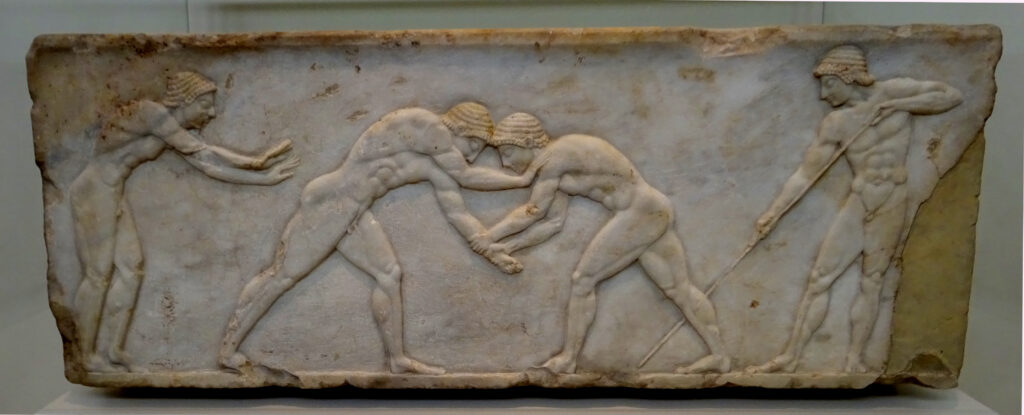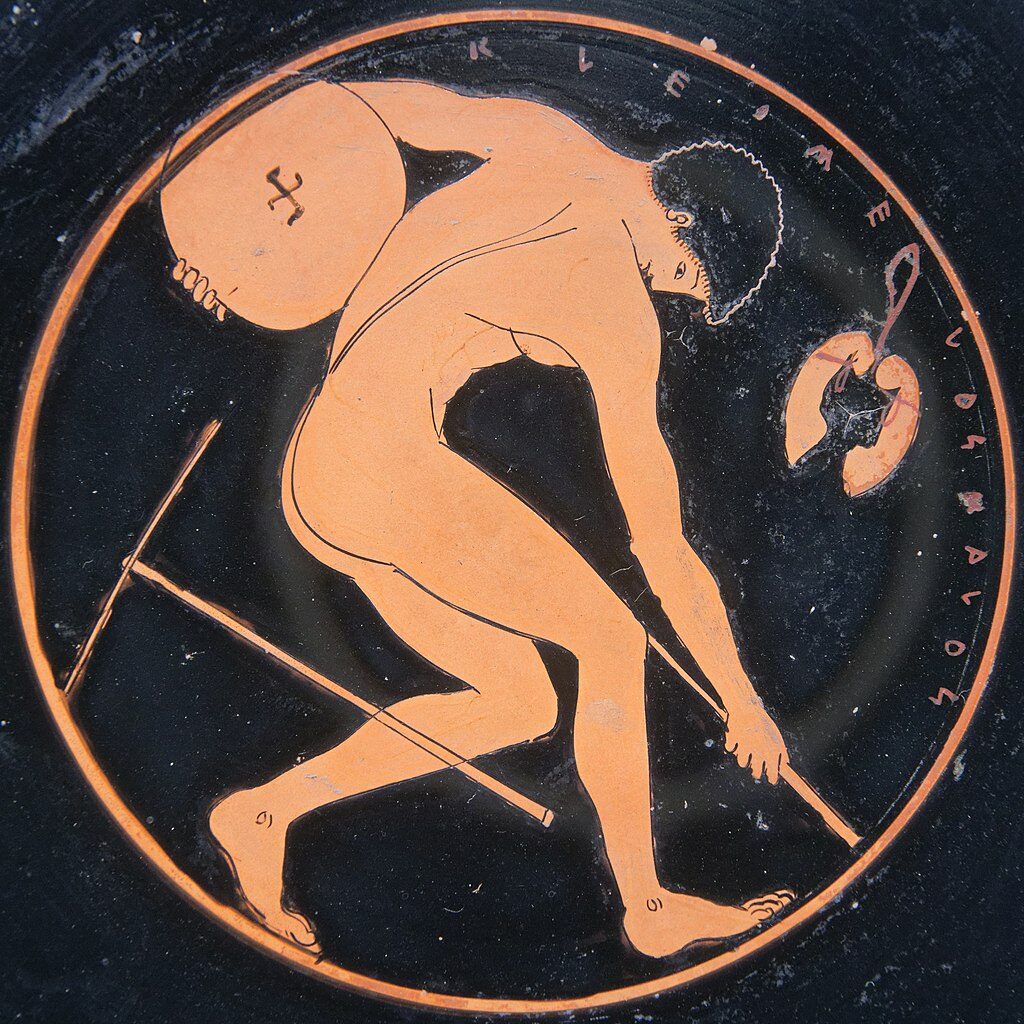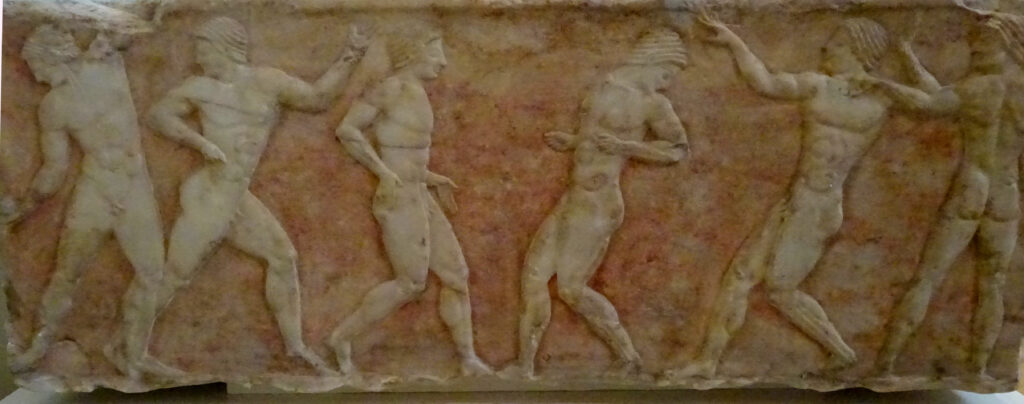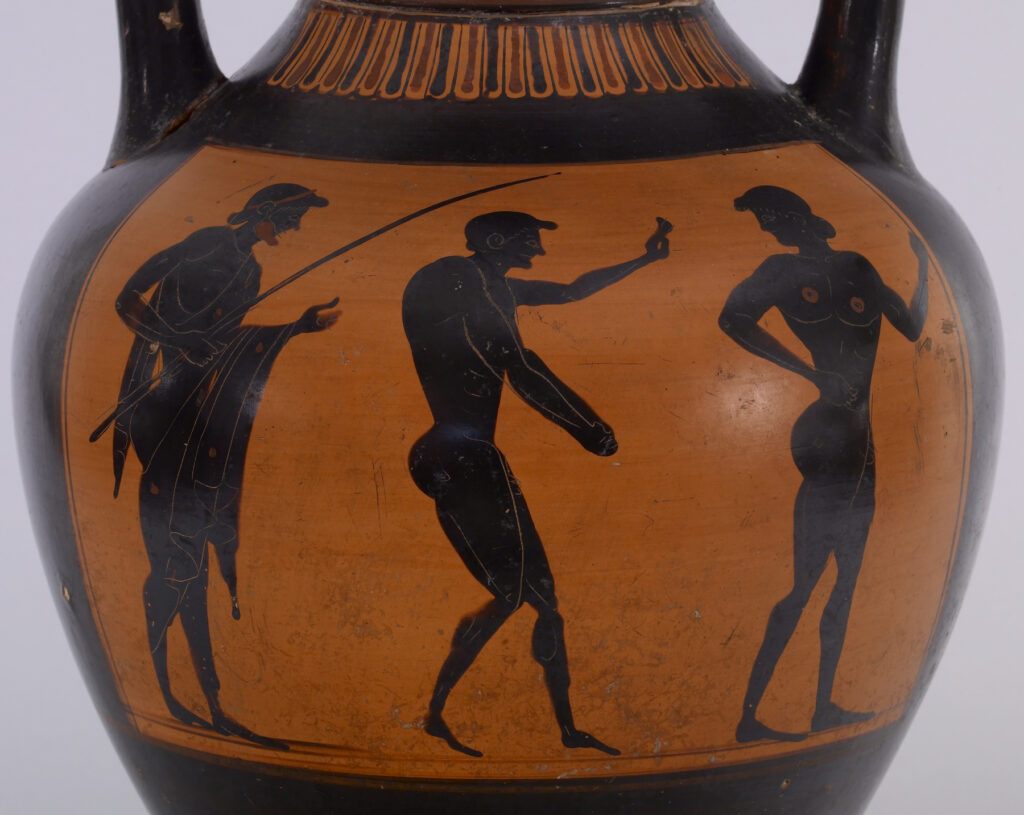To tie in with this month’s Book Club readings which include the Epinician Odes of Bacchylides, this Gallery features some ancient Greek artworks featuring the kinds of athletic contests celebrated in the poems. These contests seem to have been a favorite subject in the visual as well as the verbal arts from the earliest periods.
Chariot race
According to Britannica “From four to six chariots competed in a single race, normally consisting of seven laps around the circus. The racing chariots were light, fragile affairs, easily smashed in a collision, in which case the driver was often entangled in the long reins and dragged to death or seriously injured.”
In Ode 5 of Bacchylides one horse is specifically mentioned by name, Pherenicus (Pherenikos). His name means “Victory-bearer”.
Beside the wide-whirling Alpheus, golden-armed Dawn saw the victory of the chestnut horse Pherenicus, a runner swift as a wind-storm, [40] and she saw him win in very holy Pytho. Laying my hand on the earth, I make this declaration: never in any contest has he been fouled by the dust of faster horses [45] as he strained toward the finish-line. In force he is like Boreas; obeying his rider [kubernētēs], he speeds a new victory and new applause to hospitable Hieron.
It is not clear whether the horse was being driven or ridden: kubernētēs is used to refer to a “steersman, pilot, helmsman; guide, governor”.




Foot race
In Ode 6, Lakhōn is described as podanemon ‘wind-footed’.
In Ode 10, the victor reaches the finish-line, then “moistened the cloaks of the spectators with olive oil, rushing into the close-packed crowd when he rounded the fourth turn of the course” which sounds like a victory lap.





Wrestling
According to Wikipedia the referee had the final say on who won, but contestants could score points by having their opponent touch the ground with their back, their opponent conceding, or forcing their opponent outside the wrestling-ground.
In Ode 11 Bacchylides celebrates Alexidamos and “his all-conquering powerful wrestling [palē]. The sun did not see him, on that particular day, falling to the ground.”





Boxing
In Ode 2 Bacchylides describes the victory in the fight thrasu-kheir, ‘bold of hand’. Boxers bound their hands with thongs, which can be seen in the images.
The Greek term for boxing is pugmē. Britannia says:
The terms pugilism and prizefighting in modern usage are practically synonymous with boxing, although the first term indicates the ancient origins of the sport in its derivation from the Latin pugil, “a boxer,” related to the Latin pugnus, “fist,” and derived in turn from the Greek pyx, “with clenched fist.”







Pankration
The pan-kration, literally ‘complete strength’, was according to Middle Liddell, “an exercise which combined both wrestling and boxing (πάλη and πυγμή)” [palē and pugmē].
Britannica says “It was particularly popular among Spartans. Contests were savage, with hitting, kicking, twisting of limbs, strangling, and struggling on the ground allowed. The only recognized fouls were biting and gouging. A contest ended when one of the fighters acknowledged defeat or was rendered unconscious. In some cases, competitors died during matches.”
Judging by this image of a boxing match—in which the prevailing competitor seems to be trying to gouge his opponent’s eye, despite the gesture of submission—the rules may have sometimes been flouted!

Pentathlon
The ancient Olympic pentathlon, according to Britannica, comprised a foot race, long jump, discus, javelin, and wrestling. The definition in LSJ also lists these five events. Ode 9 is for a victory in the Nemean Games; presumably the contests were similar, although Bacchylides mentions only three of the events:
In such a way, amid the vast circling crowd of the Greeks, did he display his marvellous body, hurling the wheel-shaped discus, and raise a shout from the people as he flung the shaft of the dark-leaved elder-tree [35] from his hand into the steep sky. He executed the flashing movement of wrestling, and brought strong-limbed bodies down to the earth with such high-spirited strength.
Competitors held weights as they made the long jump, and these are depicted in some of these paintings.






Related posts
Selected vocabulary
Definitions based on LSJ.
ákōn [ἄκων, ἄκοντος, ὁ] javelin, dart
āthlos/aethlos [ἆθλος/ἄεθλος, ἄθλου/ἀέθλου, ὁ,] contest; ordeal
diskobolos [δισκο-βόλος , δισκο-βόλου, ὁ] quoit-thrower, discus thrower
dískos [δίσκος, δίσκου, ὁ] quoit, disk
dromeús [δρομεύς, δρομέως, ὁ] runner
drómos [δρόμος, δρόμου, ὁ] course, race
hálma [ἅλμα, ἅλματος, τό] spring, leap; jumping
hippos [ἵππος, ἵππου, ὁ] horse; chariot
kubernētēs [κυβερνήτης, κυβερνήτου, ὁ] steersman, pilot, helmsman; guide, governor
palaistēs [παλαιστής, παλαιστοῦ, ὁ] wrestler
pálē [πάλη, πάλης, ἡ] wrestling
pankrátion [παγκράτιον, παγκράτιου, τό] pankration (pancratium), all-in contest in boxing and wrestling
péntathlon [πένταθλον, πεντάθλου, τό] pentathlon, contest of the five exercises (ἅλμα, ποδωκείην, δίσκον, ἄκοντα, πάλην)
péntathlos [πένταθλος, πεντάθλου, ὁ] pentathlete, one who practices the πένταθλον
podánemos / podēnemos [ποδ-ήνεμος, -ον] adj. wind-swift
podōkeia [ποδώκεια, ποδωκείας, ἡ] swiftness of foot
pugmē [πυγμή, πυγμῆς, ἡ ] fist, boxing
púktēs [πύκτης, πύκτου, ὁ] boxer
púx [πύξ] adv. with the fist
Image credits
Chariot race. Clay hydria, 7th century BCE. Archaeological Museum in Herakleion
Photo: Wolfgang Sauber. Creative Commons Attribution-Share Alike 3.0 Unported, 2.5 Generic, 2.0 Generic and 1.0 Generic license, via Wikimedia Commons
Lid pyxis with depiction of chariot race. Kerameikos Archaeological Museum in Athens, 700–675 BCE
Photo: Sharon Mollerus. Creative Commons Attribution 2.0 Generic license, via Wikimedia Commons
Attributed to Priam Painter. Chariot race. Shoulder of an Attic black-figure hydria, c 510 BCE. Metropolitan Museum of Art
Photo: Marie-Lan Nguyen. Creative Commons Attribution 2.5 Generic license, via Wikimedia Commons
Panathenaic prize amphora of a chariot race, made in Athens about 410–400 BCE. British Museum.
Photo: Carole Raddato. Creative Commons Attribution-Share Alike 2.0 Generic license, via Wikimedia Commons
Sprinter on Fikellura style amphora, 6th century BCE.
Photo: Carole Raddato. Creative Commons Attribution-Share Alike 2.0 Generic license, via Wikimedia Commons
Greek vase with runners at the Panathenaic Games, c 530 BCE
Photo: MatthiasKabel. Creative Commons Attribution-Share Alike 3.0 Unported license, via Wikimedia Commons
Kleophrades Painter. Athletes running. Side B from a black-figured Panathenaic amphora, c 500 BCE
Photo: Marie-Lan Nguyen. Public domain, via Wikimedia Commons
Runners. Panathenaic Prize amphora 480–470 BCE
Photo: Marcus Cyron. Creative Commons Attribution-Share Alike 3.0 Unported license, via Wikimedia Commons
Codros Painter. Athlete running past the post, 450–400 BCE
Photo: Marie-Lan Nguyen. Creative Commons Attribution 4.0 International license, via Wikimedia Commons
Wrestlers. Attic Late Geometric oinochoe, c 715–700 BCE, from Thebes. Louvre.
Photo: Marie-Lan Nguyen (User:Jastrow). Creative Commons Attribution 2.5 Generic license, via Wikimedia Commons
Andokides Painter. Wrestlers. Amphora, c 530–525 BCE. Antikensammlung Berlin.
Photo: Sailko. Creative Commons Attribution 3.0 Unported license, via Wikimedia Commons.
Workshop of Douris. Ephebes training in wrestling. Aryballos c 490–480 BCE.
Photo: Giovanni Dall’Orto. Copyright, Giovanni Dall’Orto; all uses permitted, via Wikimedia Commons.
Painter of Athens. Wrestlers, with Nike. Archaeological Museum of Athens.
Photo: Kosmos Society
Wrestlers. Base for a funerary kouros. c 510 BCE. Archaeological Museum of Athens.
Photo: Kosmos Society
Boxers. Fragment of Mycenaean Pictoral Style krater, 1300–1250 BCE from Cyprus. British Museum
Photo: Zde. Creative Commons Attribution-Share Alike 4.0 International license, via Wikimedia Commons
Nikosthenes: Boxers wearing himantes (leather thongs bound on the fist) are about to exchange blows. The boxer on the left already has a nose-bleed. Amphora, c 550–500 BCE.
Photo: Carole Raddato. Creative Commons Attribution-Share Alike 2.0 Generic license, via Wikimedia Commons
Kleophrades Painter. Boxers and Trainer. Side B of an Attic red-figure belly-amphora, c 500–490 BCE.
Photo: Bibi Saint-Pol. Public domain, via Wikimedia Commons
Detail from: Pugilist, amphora, end of 5th century BCE.
Photo: Marcus Cyron. Creative Commons Attribution-Share Alike 3.0 Unported license, via Wikimedia Commons
Boxers. Terracotta figurines from Apulia. 3rd century BCE. Louvre.
Photo: Jastrow. Public domain, via Wikimedia Commons
Statuette of a Boxer. Bronze, 1st century BCE.
Creative Commons CC0 1.0, via The Walters Art Museum
Antimenes Painter. Boxers, side B from an Attic black-figure amphora, c 520 BCE
Photo: Marie-Lan Nguyen. Creative Commons Attribution 2.5 Generic license, via Wikimedia Commons
Boxers and Trainer. The right boxer goes down and gives up by holding up his finger. Nevertheless, his opponent continues to press him, and is therefore beaten by the referee to the left with a long rod. Side A of an Attic black-figure neck-amphora, 510–500 BCE.
Photo: MatthiasKabel. Creative Commons Attribution-Share Alike 3.0 Unported license, via Wikimedia Commons
Detail from: A competitor in the long jump, Black-figured ‘Tyrrhenian’ amphora showing athletes and a combat scene. 540 BCE.
Photo: Carole Raddato. Creative Commons Attribution-Share Alike 2.0 Generic license, via Wikimedia Commons
Kleomelos Painter. Young boy holding a discus at the palaestra. Near him, a pick to prepare the landing ground for the long jump, and a pair of dumbbells used to maintain balance during the jump. Interior of an Attic red-figure kylix, c 510–500 BCE.
Photo: Marie-Lan Nguyen. Public domain, via Wikimedia Commons
Athletes. Base for a funerary kouros. c 510 BCE. Archaeological Museum of Athens.
Photo: Kosmos Society
Pseudo-Panathenaic amphora with discus thrower, c 500–485 BCE.
Creative Commons CC0 1.0, via The Walters Art Museum
Discus thrower. Tetradrachm from Kos, c 460–440 BCE
Photo: ArchaiOptix. Creative Commons Attribution-Share Alike 4.0 International license, via Wikimedia Commons
Roman bronze copy of Myron’s Discobolos, 2nd century CE
Photo: MatthiasKabel. Creative Commons Attribution-Share Alike 3.0 Unported license, via Wikimedia Commons
Note: Images have been selected from pictures that are freely available with open source or Creative Commons licenses or from photographs sent in by community members for the purpose. The images in this post are intended to suggest the subject, rather than illustrate exactly—as such, they may be from other periods, subjects, or cultures. Attributions are based where possible by those shown by museums, or on Wikimedia Commons at the time of publication on this website.
Images accessed October 2022.
Bibliography
Online Encyclopædia Britannica articles on Chariot racing, Pankration and Pentathlon.
Middle Liddell: Liddell and Scott. An Intermediate Greek-English Lexicon. Oxford. Clarendon Press. 1889
Online at Perseus
Wikipedia article on Greek wrestling
Bacchylides. Diane Arnson Svarlien. Odes. 1991
Online at Perseus
LSJ: Liddell, Henry George, and Scott, Robert. A Greek-English Lexicon, revised and augmented throughout by Sir Henry Stuart Jones, with the assistance of Roderick McKenzie. 1940. Oxford. Clarendon Press.
Online at Perseus
Online resources accessed October 2022.
___
Sarah Scott is a member of Kosmos Society.